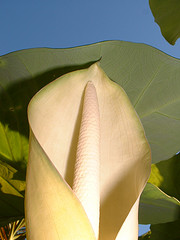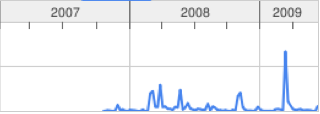Jacob casts gentle doubts on chile pepper domestication:
Intriguing explanation. But I wonder why the disperser birds and mammals are needed.
The thing is, he may be correct.
Agricultural Biodiversity Weblog
Agrobiodiversity is crops, livestock, foodways, microbes, pollinators, wild relatives …
Jacob casts gentle doubts on chile pepper domestication:
Intriguing explanation. But I wonder why the disperser birds and mammals are needed.
The thing is, he may be correct.

I am currently based in New Zealand and have access to Taro in a few varieties , via the Pacific Island communities, one of which is the wild version, which has notably black stems. This is not true of Madumbi, which also has a flower very similar to the Arum. I would be very keen to grow the South African variety as it is a very different flavour to the common Pacific Taro which as previously noted is very bland. Here is a link to a picture of the flower …
I did some more Googling, and found out a bit more about the project and its originater; depending on the story that’s either “Dr James Hartzell, a self-proclaimed ‘white boy from New York’,” or Professor Thembinkosi Modi, of the University of KwaZulu-Natal’s School of Agricultural Sciences. (Modi won a TWAS (Third World Academy of Science) Young Scientist Award in 2007.) Whatever, the end result was an organic cooperative of growers sending the amadumbe (or amadumbi) to a supermarket chain. Everything seemed rosy, with farmers reporting higher incomes that they were using to improve their lives, buying better houses, medical care, and education for their children. Except that there seems to have been a worm in the amadumbe: free-riders. Who were they?
Members who were male, poorly educated, partially certified, aware of loopholes in the grading system, and who did not trust the buyer.
The authors of the paper quoted above make specific recommendations to deal with the problem, but I cannot discover whether anything came of them. I’m also no aroid taxonomist, and frankly I’m not sure how informative the flower photo is, ((Downloaded from flickr.)) but there you have it. Now, maybe other people can chime in with more information.
Patience partially pays; Bob answers Luigi’s year-old “what the heck is it?”
The word is Zulu, but also is also anglicized as Madumbe as in Zulu the “A” is almost silent. The plant is a Taro species grown in Natal and Eastern Cape in South Africa and looks more like the common Arum than the tropical Taro, the corm looks like the Arum corm. Just boiled it is delicious, unlike the Taro which is rather bland.
What we really want (obviously) is a binomial. Anyone?
No.
Approximately two-thirds of Africa’s population labors on small, dusty farms, frequently failing to produce enough food to feed their families. Europe, North America, and Asia got their “Green Revolutions” and the ensuing productivity growth allowed small farmers to send their kids off to school in the big cities. Africa completely missed the boat.
A long article in the New York Times Freakonomics blog by Dwyer Gunn asks “Will the Green Revolution Ever Hit Africa“? It’s long, and very straightforward. While giving the naysayers a hearing, the article is firmly on the side of GMOs, fertilizer and irrigation. Oh, and forward contracts to supply the Gates Foundation’s ((And labelling it thus rather tells you where the story is coming from.)) Purchase for Progress program, cooked up so that the World Food Programme can buy emergency rations locally, injecting some cash into local economies. Because the two thirds of Africa’s people who labour “on small, dusty farms, frequently failing to produce enough food to feed their families” are going to be entering into forward contracts with WFP? Do me a favour.
I started reading the article in full optimistic flood; here was somebody who understood the issue, really understood it. I finished very, very disappointed. Round up the usual suspects. Luckily there were only three comments, and only two really annoyed me, ((Sturgeon’s Law: 95% of everything is crap really makes itself felt in large-traffic blogs)) so here’s my suggestion. Go there, but leave your comments, if you have any, here. Or, at the very least, in both places.
We’ve been keeping a weather-eye on the new strain of wheat stem rust called UG99 (it was isolated in Uganda in 1999) since very early in the history of this blog, trying to keep at least vaguely abreast of its spread and efforts to fight it. In truth, it has not been a very happy story, and if our coverage has dropped off just a bit, that may be because it can get tiresome crying wolf, no matter how much joy it might give us to be proved right.
Anyway, there’s been another outburst of interest, and while the news still isn’t good, it is fun to see how different people tell the story. First off, there’s The Hero :
Like the warrior Beowulf, subject of the Old English epic poem, [Norman] Borlaug slew a monster, saved his world and lived to a ripe old age. Like Beowulf, this old warrior of science has had to climb back into armour to battle the rise of a new monster. And once again, the world is looking to him for salvation.
Elizabeth Finkel, teller of that particular tale, certainly has a sense of drama. ((She’s also been busy lately.)) And she gives a very full account of the fight against wheat rusts in general. Across it all strides Borlaug, whom Finkel describes as “frail”. Any 95-year old is entitled to be frail, but my understanding is that he is in worse shape than that. How will the scientists and funders fare in his absence? I hope they redouble their efforts, in memoriam as it were.
Then there’s the army of soldier ants, selflessly toiling in defense of the greater good:
After several years of feverish work, scientists have identified a mere half-dozen genes that are immediately useful for protecting wheat from Ug99. Incorporating them into crops using conventional breeding techniques is a nine- to 12-year process that has only just begun. And that process will have to be repeated for each of the thousands of wheat varieties that is specially adapted to a particular region and climate.
Karen Kaplan’s story, in the LA Times, is as broad as Finkel’s, but paints a different picture. Borlaug doesn’t even get a name check. Instead, scientist after US scientist gets a brief moment to explain how complex and yet tedious the job is, how ill-prepared they were, how each depends on all the others, and how the rest of humanity depends on them. We need both stories, I think, scientist as individual hero and scientist as soldier ant, breakthrough and toil, and I hope readers get them.
Yet another narrative crops up, though. I’m not sure what to call it. Pot of Gold? Silver Lining? Unexpected Benefit?
Crop scientists have discovered a new threat to wheat crops within the United States, leading to a race to be the first to breed a resistant wheat plant, before there is trouble. Any outcome could have a big effect on related agriculture exchange traded funds (ETFs).
Setting aside all the guff about the threat being “new,” Tom Lydon, in Commodity Online, points his readers to two such exchange traded funds, noting that “fear that the fungus will cause widespread damage has caused short-term price spikes on world wheat markets”. In other words, there may be money to be made.
 Why the current spate of interest? That’s hard to say. There have been meetings in Mexico and Syria, which account for the most recent spike in Google Trends. But nothing that I have noticed more recently than that. Just coincidence, perhaps. And in all the stories about how to deal with UG99, there’s one that has been conspicuous by its absence. Don’t Put All Your Eggs in One Basket.
Why the current spate of interest? That’s hard to say. There have been meetings in Mexico and Syria, which account for the most recent spike in Google Trends. But nothing that I have noticed more recently than that. Just coincidence, perhaps. And in all the stories about how to deal with UG99, there’s one that has been conspicuous by its absence. Don’t Put All Your Eggs in One Basket.
Faced with the cost of controlling disease in monoculture, two solutions emerged – to keep producing new varieties and new fungicides. But both of these solutions led to the Red Queen problem in Lewis Carroll’s ‘Through the Looking Glass’: ‘Now, here, you see, it takes all the running you can do, to keep in the same place’. Mixtures of appropriate varieties, however, can restrict disease and increase yield reliably, without need for fungicides.
Martin Wolfe is the name perhaps most associated with the renaissance of the idea that mixtures may be the way to cope with at least some diseases. That’s something else we’ve written about before, but as far as I know there have been no trials designed specifically to ask how wheat mixtures fare under UG99. Seems at least worth a try.